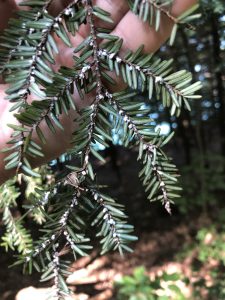ALERT: Harmful Algal Blooms (HABs) have been observed in the south eastern end of the lake. LEARN MORE
ALERT: Harmful Algal Blooms (HABs) have been observed in the south eastern end of the lake. LEARN MORE
“If we lose the hemlocks, we lose the lake” – Dr. Robert Werner, SLA visionary.

Hemlock trees are essential for a healthy lake and preventing harmful algal blooms (HABs). Hemlock trees on steep banks and in ravines provide natural sediment control which can reduce phosphorus flowing into the lake and feeding HABs. Additionally, the cover these trees provide keeps streams cool and lake temperatures lower which also helps defend against HABs.
Invasive, aphid-like insect attacking our hemlocks are called hemlock woolly adelgid (HWA) and are native to Asia. HWA are very small (1.5 mm) and often hard to see, but they can be identified by the white woolly masses they form on the underside of branches at the base of the tree needles. Their feeding severely damages the canopy of the host tree by disrupting the flow of nutrients to its twigs and needles. Tree health declines, and mortality usually occurs within four to 10 years.
The Skaneateles Lake Association has designated more than $50,000 for HWA management efforts. We contract a licensed pesticide applicator with extensive experience in treating HWA to treat designated areas within the watershed. The pesticide treatment of HWA is a bridge to the future biological treatment of using silver flies to combat HWA. Cornell University is assessing the use of releasing silver flies into areas infected with HWA as these flies actually eat the woolly adelgid. Neither pesticide treatment nor silver flies will completely eliminate HWA, but both are tools in our pocket to help these ecosystems. The effort to combat and control HWA is being carried out by both Onondaga County Soil and Water Conservation District (OCSWCD) and the Skaneateles Lake Association.
Please contact the SLA if you need help identifying possible HWA infection and we can refer you to a licensed pesticide applicator.
